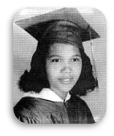This is the twenty-third issue of Voices From the Past. My goal for each issue is to publish some highlights of one of my historical stories as well as an update on my activities.
|
Barbara
Johns – A Student Leader
Look not at the face
nor the color of a person’s skin,
But look at the heart
which is deep within.
For the face and the
skin will one day fade away,
But the deed of a
good person will never decay.
That is
a poem taught at Moton High School, the black high school in Farmville, VA,
in the late 1940s and early 1950s.
This
story is about the deeds of a number of those high school students.
|

|
It
started with 16 year old junior Barbara Johns in September of 1950, when she
was confiding in her favorite teacher:
“Miss Davenport – it’s
just not fair.”
“What’s not fair,
Barbara?”
“Miss Davenport, I
missed the black bus yesterday. Mama works in Washington, DC during the week
and Daddy is always out early working on the farm. So as usual, I was busy
getting my three younger brothers and my sister ready for the bus, so busy that
I forgot my own lunch. By the time I had run home and gotten my lunch and run
back to the bus stop, the bus had already left.
“That’s a shame, Barbara,
but why is it not fair?”
“Here’s why, Miss
Davenport. While I was looking for someone to give me a ride to town, the white
bus went by. It wasn’t full, but it didn’t stop and the white kids jeered at
me. There they were going to their big new brick schools. All we have is one
old brick building, with room for only 180 students, not hardly enough room for
the 450 students who now attend our high school. None of the white schools have
three tar-paper shacks for classrooms like we do for our overflow of students,
tar-paper shacks with just one stove so the students near it are too hot, and
everyone else wears their coats, tar-paper shacks that leak every time it rains.
And our only bathrooms are in the brick high school.”
“I know all that,
Barbara. You’ve known all that for a long time. Why don’t you do something,
Barbara?”
Barbara
slowly turned away, feeling dismissed by her teacher, who was usually so
nurturing. But Barbara thought about it for days. Eventually she prayed, “God,
please grant us a new school.” She realized that she needed help, from the
seniors who were the school leaders, the twins Carrie and John Stokes. Barbara
spoke with them a number of times. Finally she had this conversation:
Barbara: “I have a new
idea. Our parents always ask us to follow them. But in some instances, a little
child will lead them. We could make a move that would broadcast Farmville all
over the world.”
Carrie: “How are we
going to do that, Barbara?”
Barbara: “We could lead
the entire Moton student body out on strike. And we’d stay out on strike until
the school board agrees to build us a new high school.”
Carrie
and John Stokes agreed to join her. Together they created a committee of student
leaders.
The
strike started on Monday, April 23, 1951 when the principal was lured out of
the school. After the principal left, message slips were delivered by other
members of the strike committee to each classroom announcing a whole school
assembly.
At 11
a.m., the 450 students and two dozen faculty members, minus the principal, were
crowded into the auditorium (built for 180.) The curtains on the stage opened
and revealed the members of the strike committee.
As usual,
they recited the Pledge of Allegiance, the Lord’s Prayer and sang a song.
Then a member
of the strike committee announced, “Teachers, would you please leave the
auditorium? This is a meeting just for students. It would be best for you that
you are not part of what we are going to do.”
The
strike committee knew that the principal and the teachers could lose their jobs
if they joined in the strike.
Then 16
year old junior Barbara Johns came to the podium.
“We need
a new high school. You can see it right now, how we’re crammed in to this
auditorium. Our principal, our teachers, our parents have all asked the school
board for a new school. The answer is always the same – there’s not enough
money.
We’ve
checked the records. The white schools for the one thousand, four hundred
white students in our county are valued at $1.2 million dollars. Each of
those schools is brick with central heating and indoor plumbing.
The black
schools for the two thousand Negro students in our county are valued at
less a third of the value of the white schools. Only 1 of those schools is
brick and has central heating and indoor plumbing – this one. But there is not
enough money, they say, to build a new black high school, big enough for all of
us.
We just
want what the law promises – separate but equal facilities. That has been the
law since the late 1800s.
Nothing
will change unless we join together and demand a new school. We must walk out
of school – go out on strike. That will get everyone’s attention.”
”Two
bits, four bits, six bits, a dollar. All for this strike, stand up and holler! Two
bits, four bits, six bits, a dollar. All for this strike, stand up and holler!”
They did – everyone stood up and hollered and followed Barbara Johns and the
strike committee out of school.
Barbara
and Carrie contacted the state chapter of NAACP in Richmond and persuaded them
to come to Farmville and listen to their problems. The NAACP agreed to file a lawsuit
demanding integrated schools, since winning lawsuits for separate but equal
facilities had produced no changes.
188
students and parents decided to take the risk and sign the integration lawsuit.
Two days later, a cross
was burned on the grounds of Moton High School. Negroes in Farmville lost the ability to
get store credit. The president of the PTA lost his job with the county. The principal
lost his job. Barbara Johns’ parents were afraid for her safety. So they sent
her to her uncle’s in Alabama for her senior year in high school.
The
Farmville lawsuit was dismissed at the federal level. The NAACP lawyers, now
including Thurgood Marshall, joined the Farmville case with four other cases for
review by the Supreme Court. These five bundled lawsuits became known as Brown
vs. Board of Education. Farmville’s lawsuit was the only case which was
student led.
After the
1954 Supreme Court ruling, as you can imagine, Barbara Johns and the other 187
signers of the lawsuit were jubilant, so pleased and justifiable proud of
themselves..
However, later
that year, when Barbara Johns’ family was visiting relatives in DC one weekend,
their house was burned down to just ashes. The family eventually moved to DC.
Let me
tell you about Farmville, VA now.
The Moton
High School, site of this student walkout in 1951, is a National Historic
Landmark – VA’s only National Historic Landmark about the civil rights
movement. It opened on the 50th anniversary of the student strike. It
depicts one of the stories behind the landmark Supreme Court case of
Brown V. Board of Education.
Look not at the face
nor the color of a person’s skin,
But look at the heart
which is deep within.
For the face and the
skin will one day fade away,
But the deed of a good
person will never decay.
Click here for more information about
Barbara Johns.
News
about me
~~~~~~~~~~~~~
On November
16, at 2 pm in the GE Theatre at Proctors in Schenectady, I will be one of
the storytellers and one of the producers for Tellabration 2014:

We chose this year's theme,
Bridging the Divide, since there seem to be many things dividing people. People
through the ages have been concerned about these divisions and have created
stories to draw people together. Four of the stories at our performance are
personal stories, two are historical stories and the rest are folk tales and
literary stories. As civil rights activist Alvah McSwain Lambert said, 'We are
all one race - the human race."
More information on Tellabration
Other news -
I finished my fourth CD - "Fighting For Our Rights: American Women
Mid 20th Century" in July. The complete story of Barbara Johns is the
first story on this CD.
Thanks for
reading this issue. I'll be sending you some more story highlights in a few
months.
Kate
http://www.katedudding.com/
kate@katedudding.com